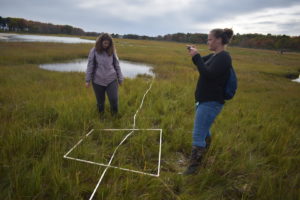 Before heading back to the Wells National Estuarine Research Reserve, the gang stopped at Thompson’s Orchard for some fall festivities – apple picking and donut eating.
Before heading back to the Wells National Estuarine Research Reserve, the gang stopped at Thompson’s Orchard for some fall festivities – apple picking and donut eating.
In Wells, the salt marsh was another strong example of zonation that we’ve seen throughout our learning. They are formed by an accumulation of river sediment that builds up along the coast. Eventually, this turns into a vast land of peat (decomposed plant matter). As we approach the seaward side of the marsh, species of plants have to be more tolerant of high salt content, be able to survive flooding twice a day, and endure other stresses such as anoxic stress.
As we go further back into tree line, we noticed that species vary based on their ability to tolerate these stressors and compete with other species. Dr. Bernacki, a biology and ecology professor, was with us for this four day section. All of our professors have really encouraged us to observe and make suggestions on our own of what we think is happening around us. One thing that was unique to this section was that we were able to work in groups of three to form our own experimental designs and test them out to see if it supported our original hypothesis’. For me, being someone in the group who just started to take science courses this summer, it was really exciting to think about what I wanted to test and how I was going to achieve that.
One group designed an experiment to test if there was a gradient of species from one salt pan to another. The other group designed an experiment that tested the richness amongst species from high tide line to tree-line.
Since September 30th, we have been on Peaks Island where one of our professors actually lives (so we officially have a new member on board the ESS, Pirate)! With just a little over 2 weeks away from the finish line, we are coming to the realization that we are going to have to say goodbye soon. We have been cherishing all of our moments together. We have spent lots of late nights together writing papers, sharing stories, laughing, and just being family. We are now heading full speed into our new course, Oceanography. Stay tuned from more about our life on the island and our journey on the schooner!





